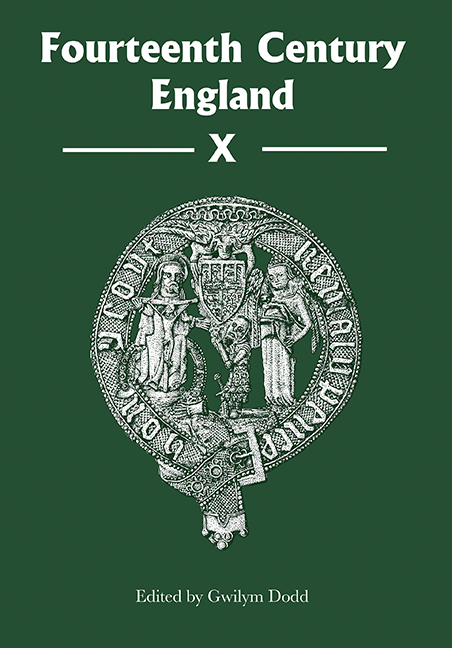Book contents
- Frontmatter
- Contents
- List of Illustrations
- Contributors
- Preface
- Abbreviations
- ‘Bought by the King Himself’: Edward II, His Chamber, His Family and His Interests in 1325–26
- Parliament in the Reign of Edward II
- The Representation of the Clergy in Parliament
- Feeding Mars: Military Purveyance in the Long Fourteenth Century
- ‘Unnatural in Body and a Villain in Soul’: Rape and Sexual Violence towards Girls under the Age of Canonical Consent in Late Medieval England
- Marriage and Inheritance: The Element of Chance in the Development of Lay Estates in the Fourteenth Century
- Mary Percy and John de Southeray: Wardship, Marriage and Divorce in Fourteenth-Century England
- Richard II's Kingship at St Stephen's Chapel, Westminster, 1377–99
- Bodies in Constant Motion: The Burials and Reburials of the Plantagenet Dynasty, c. 1272–1399
- Fourteenth Century England Issn 1471–3020
Richard II's Kingship at St Stephen's Chapel, Westminster, 1377–99
Published online by Cambridge University Press: 03 July 2019
- Frontmatter
- Contents
- List of Illustrations
- Contributors
- Preface
- Abbreviations
- ‘Bought by the King Himself’: Edward II, His Chamber, His Family and His Interests in 1325–26
- Parliament in the Reign of Edward II
- The Representation of the Clergy in Parliament
- Feeding Mars: Military Purveyance in the Long Fourteenth Century
- ‘Unnatural in Body and a Villain in Soul’: Rape and Sexual Violence towards Girls under the Age of Canonical Consent in Late Medieval England
- Marriage and Inheritance: The Element of Chance in the Development of Lay Estates in the Fourteenth Century
- Mary Percy and John de Southeray: Wardship, Marriage and Divorce in Fourteenth-Century England
- Richard II's Kingship at St Stephen's Chapel, Westminster, 1377–99
- Bodies in Constant Motion: The Burials and Reburials of the Plantagenet Dynasty, c. 1272–1399
- Fourteenth Century England Issn 1471–3020
Summary
Medieval kingship occurred in specific locations with particular resonances and contexts, such as the coronation ceremony in Westminster Abbey or the daily orders issued from wherever the king happened to be. St Stephen's Chapel and College sat within the important palace of Westminster and were thus part of Richard II's re-creation of the palace complex in the second half of his reign. The chapel was the principal chapel of the palace and the college of canons that maintained and used it were royal servants occupied with administration or serving in the king's household. By examining Richard's relationships with the chapel spaces, where he worshipped, and the college with which he feuded and yet which he protected, we can see his personal ideas about kingship at work. The chapel was not, however, his own design but rather reflected the ideas of his grandfather, Edward III, who had completed the chapel and its heraldic and dynastic decoration. Art historians have built on the work of Colvin and others in understanding the form and access of the medieval palace of Westminster in order to understand the royal patronage that created major building projects and architectural and artistic innovation. This essay is a case study in the use of these spaces and an examination of larger ideologies of kingship as they functioned within one of Richard's most important palaces. The reign of Richard II was also a critical one for St Stephen's College as it sought to firmly establish itself. This essay examines its existence at an important turning point as it both defined itself, and came to be defined, in relation to the king and the neighbouring Westminster Abbey. It is thus a study in the continuing adaptation of an institution during turbulent times. By 1399 the college was secure in its ecclesiastical rights and tenures. But it had not always looked possible.
St Stephen's Chapel and College within Westminster
Within the palace of Westminster, St Stephen's was both a building and an institution. The two-storey chapel of St Stephen and St Mary Undercroft, with the oratory of St Mary le Pew on its south side, stood on the Westminster riverfront, highly visible to passing water traffic and easily accessible from both the administrative areas and the privy palace, as seen on the plan of the palace shown below.
- Type
- Chapter
- Information
- Fourteenth Century England , pp. 157 - 178Publisher: Boydell & BrewerPrint publication year: 2018



